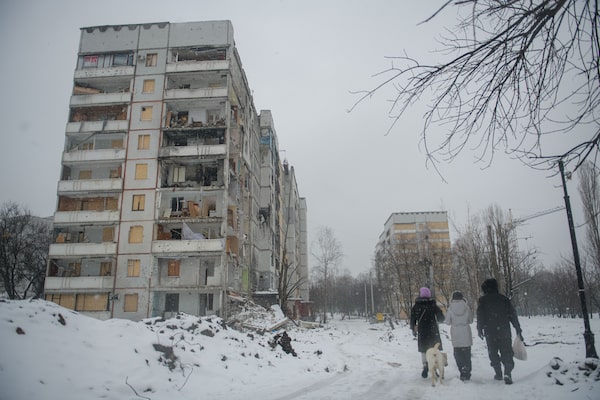
Damaged apartment buildings in the neighbourhood of North Saltivka in Kharkiv, Ukraine on Feb. 22, 2024.Olga Ivashchenko/The Globe and Mail
Natalie Slyusar has an ominous feeling again, just like two years ago. Rumours are flying about a Russian attack aimed at her home city of Kharkiv, and it’s impossible to know what to believe, or how to react.
Two years ago, few people thought a Russian invasion of Ukraine was possible. After it began on Feb. 24, 2022, Ms. Slyusar and her family were forced to repeatedly flee – first into the shelter provided by their bathroom, as bombs exploded in this city just 30 kilometres from the Russian border, then to the relative safety of places farther west in Ukraine. Now, nine months after Ms. Slyusar and her husband decided it was safe enough to return to their home on the northern edge of Kharkiv, Russian forces are again pushing forward in eastern Ukraine – and regularly striking the country’s second-largest city with missiles.

Moscow
LITHUANIA
RUSSIA
Russian control
before Feb 24, 2022
RUS.
BELARUS
Russian control
POLAND
Bucha
LUHANSK
Kyiv
Kharkiv
UKRAINE
DONETSK
ZAPORIZHYA
Odesa
Dnipro
KHERSON
Kherson
MOLDOVA
ROMANIA
Mariupol
BLACK
SEA
Rostov-
on-Don
Snake Island
Crimea
Annexed by
Russia in 2014
200km
Kerch
Bridge
graphic news

Moscow
LITHUANIA
RUSSIA
Russian control
before Feb 24, 2022
RUS.
BELARUS
Russian control
POLAND
Bucha
LUHANSK
Kyiv
Kharkiv
UKRAINE
DONETSK
ZAPORIZHYA
Odesa
Dnipro
KHERSON
Kherson
MOLDOVA
ROMANIA
Mariupol
BLACK
SEA
Rostov-
on-Don
Snake Island
Crimea
Annexed by
Russia in 2014
200km
Kerch
Bridge
graphic news

Moscow
LITHUANIA
RUSSIA
Russian control
before Feb 24, 2022
RUS.
BELARUS
Russian control
POLAND
Bucha
LUHANSK
Kyiv
Kharkiv
UKRAINE
DONETSK
ZAPORIZHYA
Odesa
Dnipro
KHERSON
Kherson
MOLDOVA
ROMANIA
Mariupol
BLACK
SEA
Rostov-
on-Don
Snake Island
Crimea
Annexed by
Russia in 2014
200km
Kerch
Bridge
graphic news
The anxiety hanging over Kharkiv captures the overall mood in the country on the second anniversary of the full-scale invasion. If the first anniversary was a slightly celebratory event – Ukraine had somehow survived everything that Russia had thrown at it, and was planning a big counteroffensive to drive the Russians out – the war’s third year begins with Ukrainian forces exhausted and low on ammunition, and with Russia back on the offensive.
On Jan. 23, a Russian missile slammed into a fire station just 300 metres from Ms. Slyusar’s apartment in the neighbourhood of North Saltivka, coming closer than any previous strike. Three windows were blown in – frames and all – covering their 18-year-old son Yarik’s bed with shattered glass.
Living under siege: Eight Ukrainians on how the war has changed them
Yarik, who is attending university in Poland, wasn’t home, but since the attack his parents have found themselves wondering whether and when they might have to leave Kharkiv again.
“It’s not a déja vu, it’s a prolongation of our nightmare,” said Ms. Slyusar, a fortysomething entrepreneur who corresponded with The Globe through the first year of the full-scale invasion. “After January 23, a lot of our neighbours left.”
In addition to the upsurge in missile attacks targeting this city, which had a prewar population of two million, Russian troops are pushing closer to the city of Kupyansk, a key transportation hub 100 kilometres to the east. If Kupyansk falls back under Russian control, as it was for the first six months of the invasion, Kharkiv would again be in Russian President Vladimir Putin’s sights. Just like two years ago.
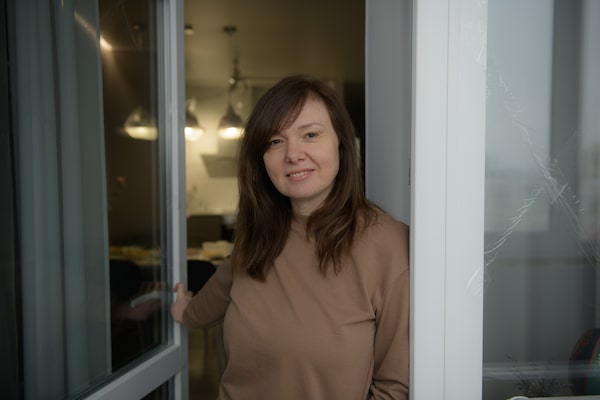
Natalie Slyusar at her home in Kharkiv, Ukraine on Feb. 22, 2024. Two years ago, Ms. Slyusar and her family were forced to flee their neighbourhood of North Saltivka.Olga Ivashchenko/The Globe and Mail
The situation would be different, Ms. Slyusar said, if the West gave Ukraine advanced fighter jets that would make Russia’s warplanes think twice about firing from just on their side of the border. However, the first of the long-awaited F-16s some NATO countries have promised aren’t expected to arrive for another four months. On Thursday, Ukrainian President Volodymyr Zelensky said only that the Ukrainian air force would receive F-16s “this year.”
“We know our army does the best with the equipment it has,” Ms. Slyusar said. “But we feel like we have no air defence.”
The question of whether it’s time to again leave Kharkiv haunts other families who fled the city early in the war, only to return after Ukrainian troops drove Russia out of most of the surrounding region in September, 2022.
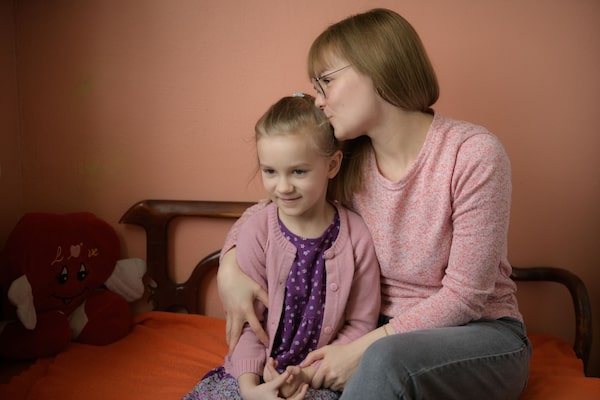
Irina Petrushenko and her daughter Katia at their home in North Saltivka on Feb. 22, 2024. Ms. Petrushenko and her family initially fled Kharkiv in March 2022, before returning last April.Olga Ivashchenko/The Globe and Mail
Irina Petrushenko and her family also left Kharkiv in March, 2022, after days of taking shelter in their bathroom as their North Saltivka apartment shook around them with nearby explosions. It was only last April that they decided it was finally safe enough to return.
For a while, it felt like the right thing to do. After a year of living in western Ukraine, where no one seemed to understand what life near the frontline was really like, it was good to be back home. Ms. Petrushenko, a PR professional, and her husband, Dmitry, a computer programmer, were able to fully resume their careers, though Ms. Petrushenko started taking anti-anxiety pills to deal with the constant threat of rocket attacks.
The fears of their six-year-old daughter, Katya, cut through everything else as the family huddled in the hallway during one of the air-raid sirens that happen several times a day here.
“I try to speak to Katya and to explain to her that we’re all together and she shouldn’t be afraid,” Ms. Petrushenko said Thursday, shortly after yet another siren sounded over the city. “But once she said to me, ‘I’m too young to die,’ and I didn’t know what to answer her.”
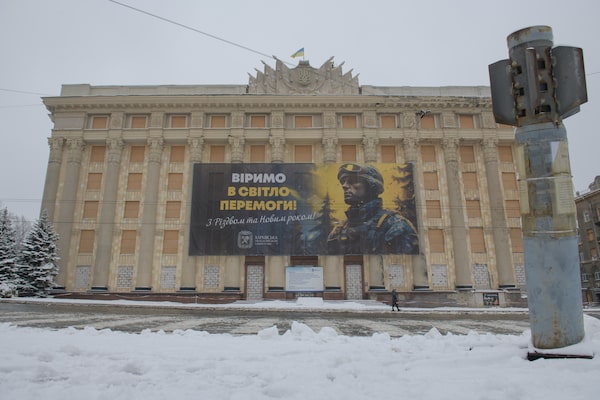
A poster promoting the Ukrainian army hangs on a building in Kharkiv, two years after the Russian invasion began.
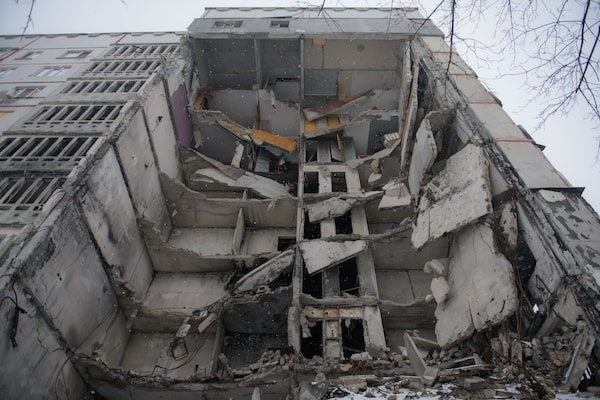
Heavily damaged apartment buildings remaining standing in the neighbourhood of North Saltivka in Kharkiv in Feb. 2024.Olga Ivashchenko/The Globe and Mail
It’s not the official narrative, but those fighting on the frontlines admit that they too are worried about the fate of Kharkiv.
If Kupyansk falls – and some of those fighting on the Ukrainian side there say it feels increasingly inevitable that it will at some point this year – a second battle for Kharkiv could soon follow.
As the West, consumed with domestic politics, pulls back from the full-on support for Ukraine it demonstrated through the first two years of the war, two senior military sources told The Globe this week that Ukrainian forces are running dangerously low on ammunition. The Globe is not naming the soldiers because they were not authorized to comment publicly on the military situation.
“We’re short on everything. Small arms, we’re okay, but if we’re speaking about 80 millimeters and higher, like mortars, artillery, shells, rockets, we’re missing those,” said one of the fighters, codenamed Den, a founding member of the special-operations unit that led the defence of Kharkiv in 2022.
“All brigades have some reserves for a sudden attack or something like that, but after that we can shoot maybe 500 rounds in two weeks. We just split it over 15 days, and you understand how much you can shoot every day. You don’t shoot like you don’t have limits.”
Russia, meanwhile, was still using “insane amounts” of artillery and airstrikes along the entire frontline, he said. Finding new recruits is another dire problem for the Ukrainians, with Mr. Zelensky reluctantly forced to order a new round of mobilization. Draft legislation that would enable the army to call up as many as 500,000 new recruits is currently before the country’s parliament.
In a report published this week, the Washington-based Institute for the Study of War said that Russian forces were following up their capture of the city of Avdiivka, in the neighbouring Donetsk region, with a new offensive aimed at Kupyansk and the wider Kharkiv region, as well as the remaining corner of the Luhansk region still under Ukrainian control.
The ISW assessed it as the most significant Russian offensive in nearly a year and a half, with attacks along four main axes that “taken together, would likely generate operationally significant gains.”
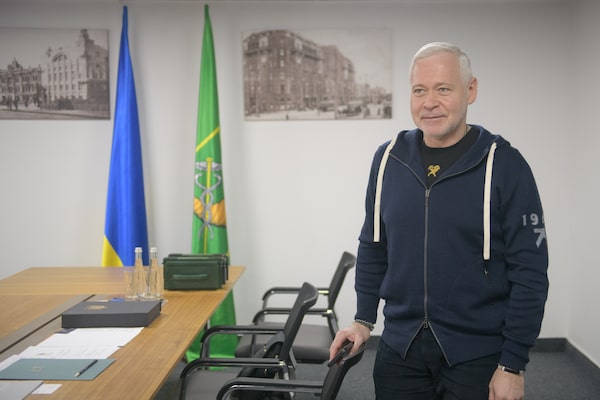
Kharkiv Mayor Ihor Terekhov says the city’s population, which had fallen to just 300,000 in March 2022, had recovered to near 1.3 million at the end of last year.Olga Ivashchenko/The Globe and Mail
Kharkiv Mayor Ihor Terekhov told The Globe that Russia’s intentions toward his city have been clear since the start of the invasion. “Putin has thought and dreamed of capturing all of Ukraine for two years,” he said in an interview at one of several offices around the city he and his staff use to avoid being targeted by missiles and Iranian-made Shahed drones.
The city’s population, which had fallen to just 300,000 in March, 2022, had recovered to near 1.3 million at the end of last year, Mr. Terekhov said, a number that included some 200,000 internally displaced persons who had moved here from places even closer to the frontline. But the situation was now starting to tip back in the other direction.
“When we have huge missile attacks, Shaheds, explosions in the city, we have some migration of people from Kharkiv,” Mr. Terekhov said. “These are chaotic strikes, targeting residential buildings, critical infrastructure. I don’t see some real purpose for these strikes – from what I see, the main purpose of these strikes is to terrify people.”
Mr. Terekhov said he viewed the talk of another Russian advance toward Kharkiv the same way. “This is part of a psychological and informational attack – to put stress on people and force them to move out from the city.”
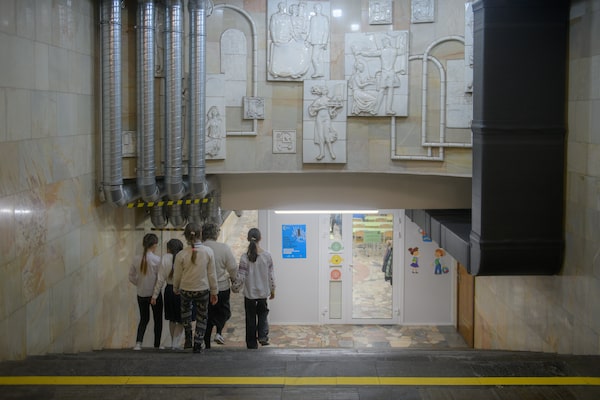
Students attend a school beneath the streets of Kharkiv, one of dozens that have sprung up underground in the city’s sprawling subway system.Olga Ivashchenko/The Globe and Mail
The Thursday morning lesson in Anastasiya Kravchenko’s third-grade English classroom is about inserting the negative. The lesson – “I was NOT in the park” – has extra resonance in Ms. Kravchenko’s classroom, which is one of dozens located underground in Kharkiv’s sprawling subway system. The children have no outdoor time at all during their school days.
The advantages of underground learning are made clear at 10:08 a.m., when yet another air-raid siren screams through the city above. The English lessons continue. “I was NOT in the theatre,” the class repeats after Ms. Kravchenko.
“My father told me the war started in 2014 with Crimea and Donbas,” eight-year-old Anya Sobko says during a break between lessons, referring to the Russian annexation of Crimea and the proxy war that the Kremlin launched in the Donetsk and Luhansk regions of Ukraine. But Anya struggles to explain what the war is about. “My parents never told me why.”
“I have very bad feelings about the war,” says 10-year-old Bohdan Medvedkov, who is older than his classmates after a missing a year while his family was living in western Ukraine after fleeing Kharkiv. “I understand that a lot of people have been killed for nothing.”
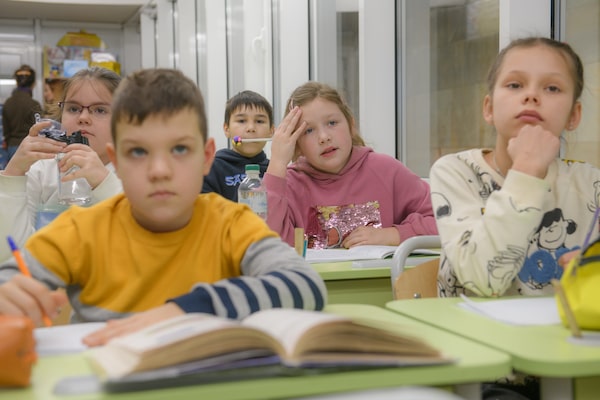
Students sit for a lesson at a school located underground in one of Kharkiv's subway stations.Olga Ivashchenko/The Globe and Mail
Like the rest of their classmates, Anya and Bohdan accept their underground schooling as normal. After two years of classes cancelled by the pandemic, and now two years of war, their generation has yet to experience a normal school year.
Above their classroom is the city’s central Freedom Square, which bears deep scars from the past two years. All the windows of the six-storey regional administration building, struck by a missile salvo in the first days of the war, remain boarded up. Facing the same central plaza, the city’s premier Kharkiv Palace Hotel has fresher wounds, with three of its top floors blown out by a Dec. 30 missile strike.
Despite their battered surroundings, Ms. Kravchenko says she draws inspiration from her pupils, who spring up from their desks and launch into a world of games and imagination as soon as their lessons end. “Sometimes I am teaching but I am learning from them. How to smile, how to enjoy this world.”
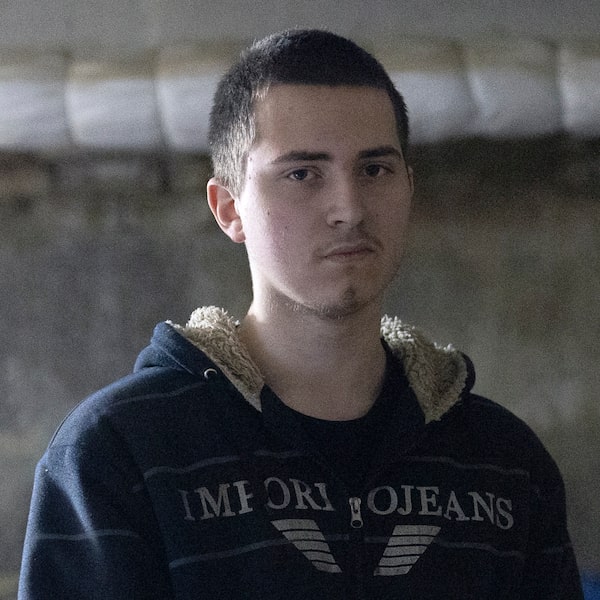
Yevhen Kryvoruchko, then 18, in the basement of School 127 in Kharkiv, Ukraine on Sept. 14, 2022.Anton Skyba/The Globe and Mail
For 20-year-old Yevhen Kryvoruchko – another of the Ukrainians The Globe followed through the first year of the war – the increasing frequency of the Russian strikes on Kharkiv brings back memories of 2022. As Russia pounded Kharkiv, he and his mother spent eight months living with other North Saltivka residents in the basement of his former high school.
Mr. Kryvoruchko and his mom are back at home now, and his focus is on his computer science studies, which are conducted via Zoom since the Kharkiv National Pedagogical University has been an online-only institution since the start of the war. His other goal is to try to maintain something like a normal social life.
“I’m studying each day and trying to fix my health mentally and physically these days,” he said in an exchange of messages. When he isn’t studying, he is visiting the burgeoning café scene in Saltivka – he asked The Globe not to name the cafés, in case they became targets – or going to the cinema with his friends.
Mr. Kryvoruchko is protected, for now, from being drafted because he’s still a student. But like every other fighting-age male in the country, he’s waiting to see the exact wording of the new mobilization bill. “What would I do there?” the tall and lanky student, whose other passion is speed-solving his Rubik’s Cube, says of joining the army.
The shelter under his former high school has been closed, but Mr. Kryvoruchko said that anyone living in Kharkiv is constantly aware of how far they are from a bomb shelter. “Watch closely where the nearest underground station is, or any basement, it could save your lives,” he advised. “It’s a lottery,” he wrote. “Missiles can land anywhere.”
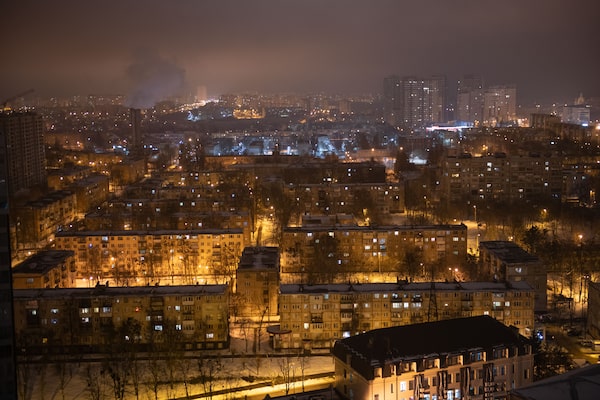
Two years after the full-scale invasion of Ukraine began, the city of Kharkiv is illuminated by the lights of its remaining residents.Olga Ivashchenko/The Globe and Mail
Back at their home in North Saltivka, where windows of Yarik’s room have been covered with a thin wall of plywood and insulation, Ms. Slyusar’s husband, political scientist Mykhailo Kamchatnyi, wonders how long he and his family and their city will have to live in limbo.
While most Ukrainians – including he and Ms. Slyusar – still see a ceasefire as pointless, since only it will only give Russia time to re-arm, opinion polls suggest a growing number of Ukrainians are willing to cede Russia some territory in exchange for an end to the invasion.
War fatigue is also growing among Ukraine’s allies in the West, alongside a creeping fear that Mr. Putin will eventually prevail. A recent poll of citizens of 12 European Union countries, conducted just before the fall of Avdiivka, found that only 10 per cent of respondents viewed a Ukrainian victory as the most likely outcome of the war, while twice as many predicted a Russian triumph and 37 per cent expected some kind of “compromise settlement.”
On the first anniversary of the invasion, which followed the liberation of Kupyansk and most of the Kharkiv region, a popular dinnertime toast was “until victory.” Victory, in Ukraine, means liberating all the land that Russia holds, including Crimea and Donbas.
A year later, after the failed Ukrainian counteroffensive and the new Russian attacks, “‘until victory’ is not so popular anymore,” Mr. Kamchatnyi said. “There are more and more pessimists now. More and more people who just want this to be over.”